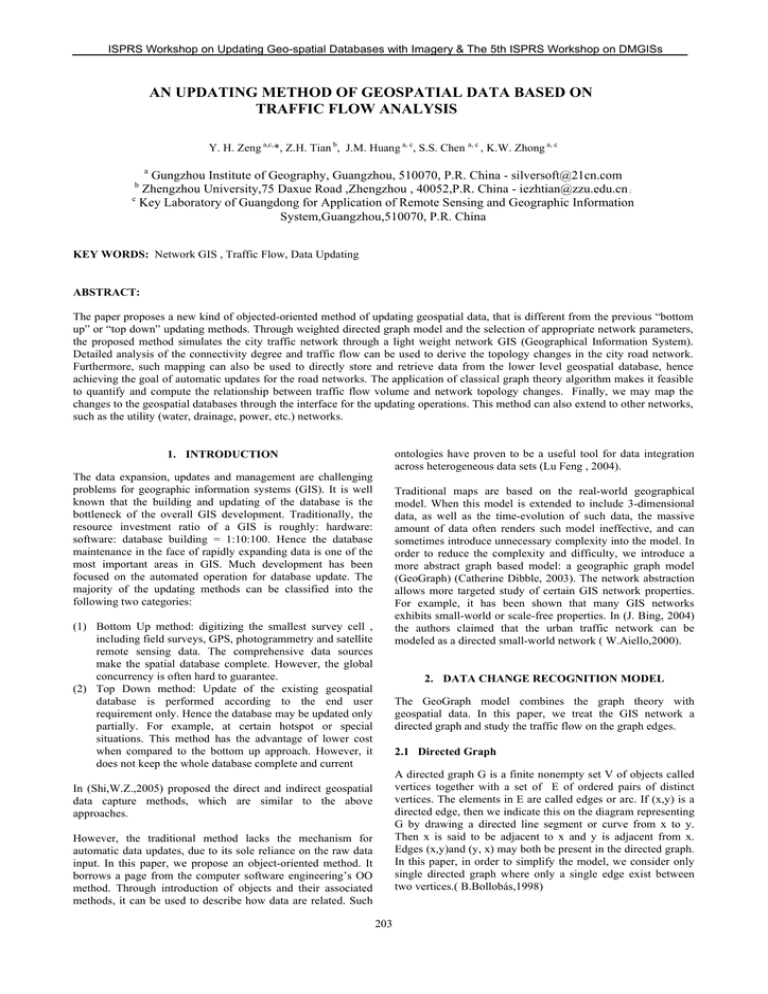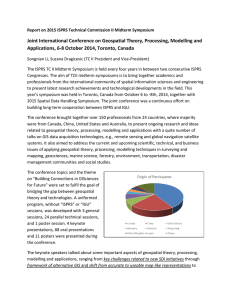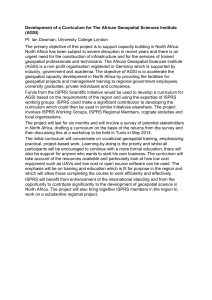AN UPDATING METHOD OF GEOSPATIAL DATA BASED ON TRAFFIC FLOW ANALYSIS
advertisement

ISPRS Workshop on Updating Geo-spatial Databases with Imagery & The 5th ISPRS Workshop on DMGISs
AN UPDATING METHOD OF GEOSPATIAL DATA BASED ON
TRAFFIC FLOW ANALYSIS
Y. H. Zeng a,c,*, Z.H. Tian b, J.M. Huang a, c, S.S. Chen a, c , K.W. Zhong a, c
a
Gungzhou Institute of Geography, Guangzhou, 510070, P.R. China - silversoft@21cn.com
Zhengzhou University,75 Daxue Road ,Zhengzhou , 40052,P.R. China - iezhtian@zzu.edu.cn ;
c
Key Laboratory of Guangdong for Application of Remote Sensing and Geographic Information
System,Guangzhou,510070, P.R. China
b
KEY WORDS: Network GIS , Traffic Flow, Data Updating
ABSTRACT:
The paper proposes a new kind of objected-oriented method of updating geospatial data, that is different from the previous “bottom
up” or “top down” updating methods. Through weighted directed graph model and the selection of appropriate network parameters,
the proposed method simulates the city traffic network through a light weight network GIS (Geographical Information System).
Detailed analysis of the connectivity degree and traffic flow can be used to derive the topology changes in the city road network.
Furthermore, such mapping can also be used to directly store and retrieve data from the lower level geospatial database, hence
achieving the goal of automatic updates for the road networks. The application of classical graph theory algorithm makes it feasible
to quantify and compute the relationship between traffic flow volume and network topology changes. Finally, we may map the
changes to the geospatial databases through the interface for the updating operations. This method can also extend to other networks,
such as the utility (water, drainage, power, etc.) networks.
ontologies have proven to be a useful tool for data integration
across heterogeneous data sets (Lu Feng , 2004).
1. INTRODUCTION
The data expansion, updates and management are challenging
problems for geographic information systems (GIS). It is well
known that the building and updating of the database is the
bottleneck of the overall GIS development. Traditionally, the
resource investment ratio of a GIS is roughly: hardware:
software: database building = 1:10:100. Hence the database
maintenance in the face of rapidly expanding data is one of the
most important areas in GIS. Much development has been
focused on the automated operation for database update. The
majority of the updating methods can be classified into the
following two categories:
Traditional maps are based on the real-world geographical
model. When this model is extended to include 3-dimensional
data, as well as the time-evolution of such data, the massive
amount of data often renders such model ineffective, and can
sometimes introduce unnecessary complexity into the model. In
order to reduce the complexity and difficulty, we introduce a
more abstract graph based model: a geographic graph model
(GeoGraph) (Catherine Dibble, 2003). The network abstraction
allows more targeted study of certain GIS network properties.
For example, it has been shown that many GIS networks
exhibits small-world or scale-free properties. In (J. Bing, 2004)
the authors claimed that the urban traffic network can be
modeled as a directed small-world network ( W.Aiello,2000).
(1) Bottom Up method: digitizing the smallest survey cell ,
including field surveys, GPS, photogrammetry and satellite
remote sensing data. The comprehensive data sources
make the spatial database complete. However, the global
concurrency is often hard to guarantee.
(2) Top Down method: Update of the existing geospatial
database is performed according to the end user
requirement only. Hence the database may be updated only
partially. For example, at certain hotspot or special
situations. This method has the advantage of lower cost
when compared to the bottom up approach. However, it
does not keep the whole database complete and current
2. DATA CHANGE RECOGNITION MODEL
The GeoGraph model combines the graph theory with
geospatial data. In this paper, we treat the GIS network a
directed graph and study the traffic flow on the graph edges.
2.1 Directed Graph
A directed graph G is a finite nonempty set V of objects called
vertices together with a set of E of ordered pairs of distinct
vertices. The elements in E are called edges or arc. If (x,y) is a
directed edge, then we indicate this on the diagram representing
G by drawing a directed line segment or curve from x to y.
Then x is said to be adjacent to x and y is adjacent from x.
Edges (x,y)and (y, x) may both be present in the directed graph.
In this paper, in order to simplify the model, we consider only
single directed graph where only a single edge exist between
two vertices.( B.Bollobás,1998)
In (Shi,W.Z.,2005) proposed the direct and indirect geospatial
data capture methods, which are similar to the above
approaches.
However, the traditional method lacks the mechanism for
automatic data updates, due to its sole reliance on the raw data
input. In this paper, we propose an object-oriented method. It
borrows a page from the computer software engineering’s OO
method. Through introduction of objects and their associated
methods, it can be used to describe how data are related. Such
203
ISPRS Workshop on Updating Geo-spatial Databases with Imagery & The 5th ISPRS Workshop on DMGISs
2.2 Flow on the Graph
path is congested or closed, then we model c(xi,yj) as a
negative power law function from experience. Hence we have
In the directed graph model, we refer the vertex (node) as the
road intersection, and the edge connecting any two vertices (x,y)
as the street road connecting the two intersections in one
direction. The out-degree of a vertex is the number of edges
originating from the vertex and the in-degree of the a vertex is
the number of edges terminating at the vertex. Such connected
vertices form the entire traffic network.
As the time function f(a / T ⁿ) is negative power law , so the
⊿ f(a / T ⁿ) and ⊿ v(f) is also to negative power law .
A flow f is a non-negative function defined on the edges; the
value f(x,y) is the amount of traffic on the edge (x,y). The
traffic flow from the source (s) to the destination (t) satisfies the
Kirchhoff’s current low: the total current flowing into each
intermediate vertex (that is the vertex different from s and t ) is
equal to the total current leaving the vertex. For any x∈V we
define two neighborhood of x:
If we monitor the max-flow continuously and observe that a
negative power law phenomenon appears in a time-window,
then we can say the congestion has emerged. Through the
Depths First Algorithm’s Searching, we can easily find the
E(x, y) is the congested or closed edges in the graph. We can
then display a message regarding the condition of the
corresponding road.
Ґ+(x)={y∈V:
Ґ- (x)={y∈V:
xy∈E}
(1)
yx∈E}
(2)
v(f) = C’(x,y) + f(a / T ⁿ) = C + f(a / T ⁿ)
and
⊿ v(f) = ⊿ f(a / T ⁿ)
(7)
3. DATA CAPTURE ANALYSIS
Figure 1 is displays the Guangzhou city’s old business area’s
street networks. We selected the main and large street cross’s
information as the sample points. All the roads are one-way
streets drawed in the graph, then we obtain the dynamic road
state information as it displayed. The numbers(0,1,2…29) are
the IDs. of the vertices which referred as street crosses. We let
them flow in from 0 and flow out on 29. The flow volume data
can be acquired from City Traffic Control Centre or recorded
from the field sampling points.
Then a flow from s to t satisfies the following equation:
∑f(x,y) = ∑f(z,x)
(3)
y∈Ґ+ (x)
z∈Ґ- (x)
where + deontes the direction flowing out and - deontes the
direction flowing into.
2.3 Maximum Flow and Minimum Cut Theorem
We denote v(f) as the value of “f “ or the amount of flow from s
to t; c(x,y) is a non-negative number called the capacity of the
edge.
Given two subsets X,Y of V, we write E(X,Y) for the set of
directed X-Y edges:
E(X,Y)= {xy∈E : x∈X y∈Y}
(4)
If S is a subset of V containing s but not t then E (S, ¯S¯ ) is
called a cut separating s from t. Here ¯S¯= V –S is the
complement set of S. If we delete the edges of a cut then no
positive-value flow from s to t can be defined on the remainder.
The capacity of a cut E (S, ¯S¯) is c(S, ¯S¯ ) . It is easily seen
from the definition that the capacity of a cut is at least as large
as the value of any flow from s to t, so the minimum of all cut
capacities is at least as large as the maximum of all flow values.
That’s max-flow min-cut theorem of Ford and Fulkerson:
v(f) ≦ ∑c(x,y)
xy∈E
v(f) = ∑c(x,y) = c(S, ¯S¯ ) x∈S,y∈¯S¯
(5)
(6)
Figure 1: A traffic max-flow network graph
in Guangzhou urban center :
Utilizing (5) and (6), Edmond and Karp designed an algorithm
that find the maximum flow on G with complexity of O(m3)
(M.H.Alsuwaiyel,1999), where m is vertex size of the network.
From the Fig. 1, we suppose that the edge E(14,15) is congested
and the flow is gradually slowing down to 0 as a negative
power law,
As the equation (1),(2),(3), we have
f(13,14)+f(10,14)= f(14,15)+f(14,21). When the f(14,15)= 0,
then the f(13,14),f(10,14) will decrease quickly and f(14,21)
will increase the flow amount of ⊿f. We use the Depths First
Algorithm’s to find the E(14,15) is the true congested edge.
2.4 Variation of Flow
Consider a city road networks that goes through changes and
repairs. Without losing generality, we view the c(x, y) as a
constant value when the road network is working well. If some
204
ISPRS Workshop on Updating Geo-spatial Databases with Imagery & The 5th ISPRS Workshop on DMGISs
Then, we can transform the updating road message to the
database.
In the above function list, we can operate the center
objects(vertices), length(edge) and area(graphs) to analogue the
network GIS’s topology and features(attributes).
4. GEOSPATIAL DATABASE UPDATE
Finally, through network GIS model structure, and the objectoriented-relational database, we can achieve the automated
database updates. Such approach can effectively use the
network’s dynamic and mobile ability to mitigate the
conservative nature of geospatial data.
4.1 Updating Client
In the GIS business market, there are many kinds of geodatabase to used and developed , if we were to develop a
updating client for each geo-database, it would be difficult and
also unnecessary. Therefore, in this paper, we design a general
software middleware agent analogous to a SDE(Spatial Data
Engine). Its task is to manage the geospatial data’s lifecycles.
The middleware agent can search the flow of any road segments.
If the flows on the segments changing with certain predefined
pattern (such as negative power law), we can conclude that the
whole road is repairing or changing. Hence, we can display the
road change message and update the database automatically.
5. CONCLUSIONS
In this paper, we proposed a dynamic network data model for
the GIS geospatial database. The automatic update of the
database are achieved by quickly capture the traffic flow
change and through network search algorithm, finding the
specific network edge that causes the flow changes. This
approach can be conveniently applied to many GIS applications.
4.2 Geo-database’s Structure
REFERENCES
Considering the Open-GIS’s architectures as a trend for future
development, we select the open source and the traditional
business database : PostgreSQL. It’s similar to the famous
MySQL database. But the frontend has a PostGIS extention
model for the support for geographic objects. PostGIS "spatially
enables" the PostgreSQL server, allowing it to be used as a
Function
Return Type
A.Hosseini naveh,et.al.,2006.Studying the effect of traffic
elements by GIS.Map World Forum,Hyderabad, India.
B.Bollobás,1998.Modern Graph Theory. Springer-Verlag New
York,pp.68-72.
Catherine Dibble, Philip G. Feldman, 2003.The GeoGraph 3D
Computational Laboratory. the 8th International Command and
Control Research and Technology Symposium.
Description
area(object)
double
precision
area
Center(object)
point
center
diameter(circle)
double
precision
diameter of
circle
Height(box)
double
precision
vertical size of
box
isclosed(path)
boolean
a closed path?
Isopen(path)
boolean
an open path?
Length(object)
double
precision
length
npoints(path)
int
number of points
npoints(polygon) int
number of points
Pclose(path)
path
convert path to
closed
popen(path)
path
convert path to
open
width(box)
double
precision
horizontal size
of box
Chen Tao,Chen Sen-fa, 2006.An Algorithm for Dynamic Core
of Transport Network with Applications.Journal of
Transportation Systems Engineering and Information
Technology Vol.6 No.2.Computing, Orlando.
Frauke Heinzle, Karl-Heinrich Anders, and Monika Sester,
2006.Pattern Recognition in Road Networks on the Exampleof
Circular Road Detection. Raubal et al. (Eds.): GIScience, LNCS
4197, Springer-Verlag Berlin Heidelberg, pp. 153 –167.
I. Budak Arpinar, et.al, 2004.Geospatial Ontology Development
and Semantic Analytics. Handbook of Geographic Information
Science.Eds: J. P. Wilson and A. S. Fotheringham, Blackwell
Publishing .
Jiang B. ,C. Claramunt, 2004.Topological Analysis of Urban
Street Networks, Envirenment and Planning B, pp.151-161.
Lu Feng, Shen Paiwei, Zhang Mingbo, 2004. Feature-based
Object
Oriented
Geographical
Network
Modeling.
Geo-Information Science.Vol.6,No.3,pp.72-78
M.H.Alsuwaiyel,1999.Algorithms Techniques and Analysis.
World Scientific Publishing Co,pp.260-269
Table1:PostgreSQL/PostGIS 8.2 Geometric Functions Tables:
Mark T. Elmore Thomas E.Potok and Frederick T. Sheldon,
2003. Dynamic Data Fusion Using An Ontology-Based
Software Agent System. Proceedings of the IIIS Agent Based
backend spatial database for GIS. Much like ESRI's SDE or
Oracle's Spatial extension. When we manipulate the geospatial
objects, the following geometric functions can be called from
library.
Shi,W.Z.,2005.Principle of modeling uncertainties in
spatial data and analysis. Science Press, Beijing
205
ISPRS Workshop on Updating Geo-spatial Databases with Imagery & The 5th ISPRS Workshop on DMGISs
W.Aiello,F.Chung,L.Lu,2000.Random graph model for massive
graphs, Proceedings of the Thirty-Second Annual ACM
symposium on Theory of Computing,pp.171-180.
Zhang Linguang, 2006.Implement and Optimization Research
of GIS Network Analysis Algorithms for Large Amounts of
Data, Graudate Dissertation, Graduate University of Chinese
Academy of Sciences, Beijing.
206




